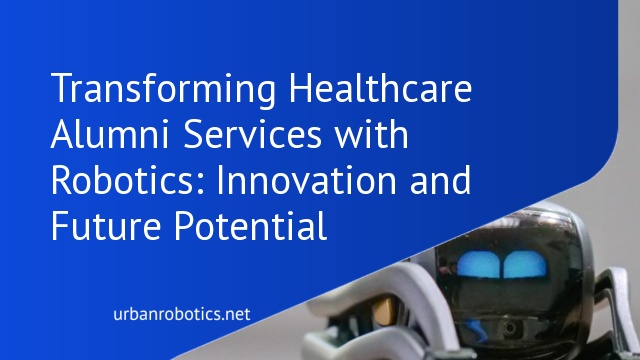Overview of Healthcare Alumni Services
Healthcare alumni services play a crucial role in supporting former students as they transition to practicing professionals. These services offer resources like mentorship programs, continued education courses, and networking opportunities. Alumni benefit from staying connected with their alma mater, enabling them to continually advance their skills and knowledge.
Robotics integration elevates these services by providing advanced learning tools and streamlined operational support. Automated systems offer personalized learning modules, allowing alumni to refine their skills at their own pace. Networking platforms use AI-driven analytics to match alumni with mentors and job opportunities, enhancing professional growth and connectivity.
Robotic tools also contribute to improved patient care techniques shared through alumni services. Simulated training environments with robotic patients help alumni practice complex medical procedures safely. This hands-on experience ensures that healthcare professionals remain adept and confident in their skills.
Healthcare alumni services augmented by robotics ensure that former students continuously enhance their expertise, benefiting both their careers and the quality of patient care.
The Integration of Robotics in Healthcare
Robotics is transforming healthcare by providing innovative solutions to improve patient care, streamline operations, and enhance medical training. This section delves into the key innovations and benefits that robotics brings to healthcare.
Key Innovations in Robotics
Robotics in healthcare has led to several technological advancements. Surgical robots like the Da Vinci Surgical System enable precise, minimally invasive procedures. Autonomous mobile robots (AMRs) transport medical supplies within hospitals. Robotic prosthetics and exoskeletons aid in patient rehabilitation. Telepresence robots facilitate remote consultations, enhancing accessibility to specialist care.
Benefits of Robotics in Healthcare
Robotics offers numerous benefits to healthcare systems. Improved precision during surgical procedures reduces recovery time and enhances patient outcomes. Automation of routine tasks allows medical staff to focus on patient care. Robot-assisted rehabilitation accelerates recovery for patients with mobility impairments. Additionally, remote consultations via telepresence robots expand patient access to healthcare services, particularly in underserved areas.
How Robotics Enhances Alumni Services
Robotics technology plays a crucial role in enhancing healthcare alumni services by offering innovative solutions for networking, education, and professional growth.
Networking Opportunities
Robotics facilitates alumni networking through AI-driven platforms. These platforms use intelligent algorithms to match alumni with similar interests, expertise, and career goals. Automated event coordinators schedule virtual meetups and conferences, enabling alumni to reconnect and collaborate on projects.
Educational Programs and Workshops
Robotics significantly improves the delivery of educational programs and workshops for healthcare alumni. Advanced robots create engaging simulated training environments where alumni can practice new skills. Additionally, AI-powered mentorship programs offer personalized learning experiences, adapting content to individual alumni needs and progress.
Success Stories and Case Studies
Associations between robotics and healthcare alumni services reveal significant achievements. Various case studies highlight the impactful integration of robotics in this field.
Notable Institutions
Numerous institutions spearhead the successful adoption of robotics in healthcare alumni services. For example, Johns Hopkins University employs robotic simulators for skill enhancement workshops. Mayo Clinic uses AI-driven platforms for efficient alumni networking. At Stanford Medicine, robotic systems assist in telepresence mentoring, bridging alumni with current students.
Impact on Alumni Engagement
Robotics transforms alumni engagement through innovative methods. AI platforms analyze interests, facilitating meaningful connections. Telepresence robots provide real-time mentorship, allowing alumni to share real-world insights. Simulated training environments keep alumni updated with the latest medical advancements, strengthening their engagement and continuous learning.
Challenges and Considerations
Implementing robotics in healthcare alumni services offers numerous benefits; however, several challenges and considerations need attention.
Ethical Concerns
Integrating robotics into healthcare alumni services raises ethical concerns. Privacy is paramount, as data privacy laws mandate stringent measures to protect alumni information. Consent is essential, requiring clear communication about data usage. Transparency in decision-making ensures stakeholders understand robotic systems’ roles and limitations. Addressing these ethical concerns is vital for building trust and maintaining the integrity of healthcare alumni services.
Financial and Logistical Barriers
Deploying robotic solutions often involves substantial financial investment. Initial costs for purchasing, installing, and maintaining robots can be high, deterring some institutions. Logistical barriers include ensuring technical staff availability and robot training for effective use. Institutions must also consider integration with existing systems, which can be complex and costly. Proper planning and resource allocation are crucial for overcoming these financial and logistical challenges.
The Future of Robotics in Healthcare Alumni Services
Robotics holds immense potential for the evolution of healthcare alumni services. Advanced robotics technologies can enable continuous learning and professional development, even after formal education. Alumni can access tailored learning modules with the help of AI-driven robots, ensuring up-to-date knowledge in rapidly advancing medical fields.
Networking opportunities improve significantly with robotics. AI-powered platforms can connect alumni with experts and fellow professionals, fostering collaboration and knowledge sharing. For instance, intelligent matchmaking algorithms can pair alumni with mentors who offer relevant expertise, enhancing career growth.
Robotics also aids in practical skills enhancement. Simulated training environments, powered by robotic systems, enable alumni to practice complex medical procedures without the need for a physical setup. These simulations can replicate real-life scenarios, offering hands-on learning while minimizing risks.
Institutions investing in robotics for alumni services can expect operational efficiencies. Automated systems handle routine tasks, freeing up time for alumni to focus on impactful endeavors. This streamlined approach contributes to the overall effectiveness of healthcare education and practice.
Conclusion
Robotics is undeniably revolutionizing healthcare alumni services. By offering personalized learning and advanced training environments we’re setting new standards in medical education. AI-driven platforms are enhancing our networking opportunities making it easier to stay connected and share knowledge. The success stories from leading institutions like Johns Hopkins Mayo Clinic and Stanford Medicine highlight the transformative power of integrating robotics into alumni services. As we look to the future embracing robotics will be essential for continuous learning and operational excellence. Let’s navigate the ethical considerations and financial challenges with proper planning and transparency to fully harness the potential of robotics in healthcare alumni services.





